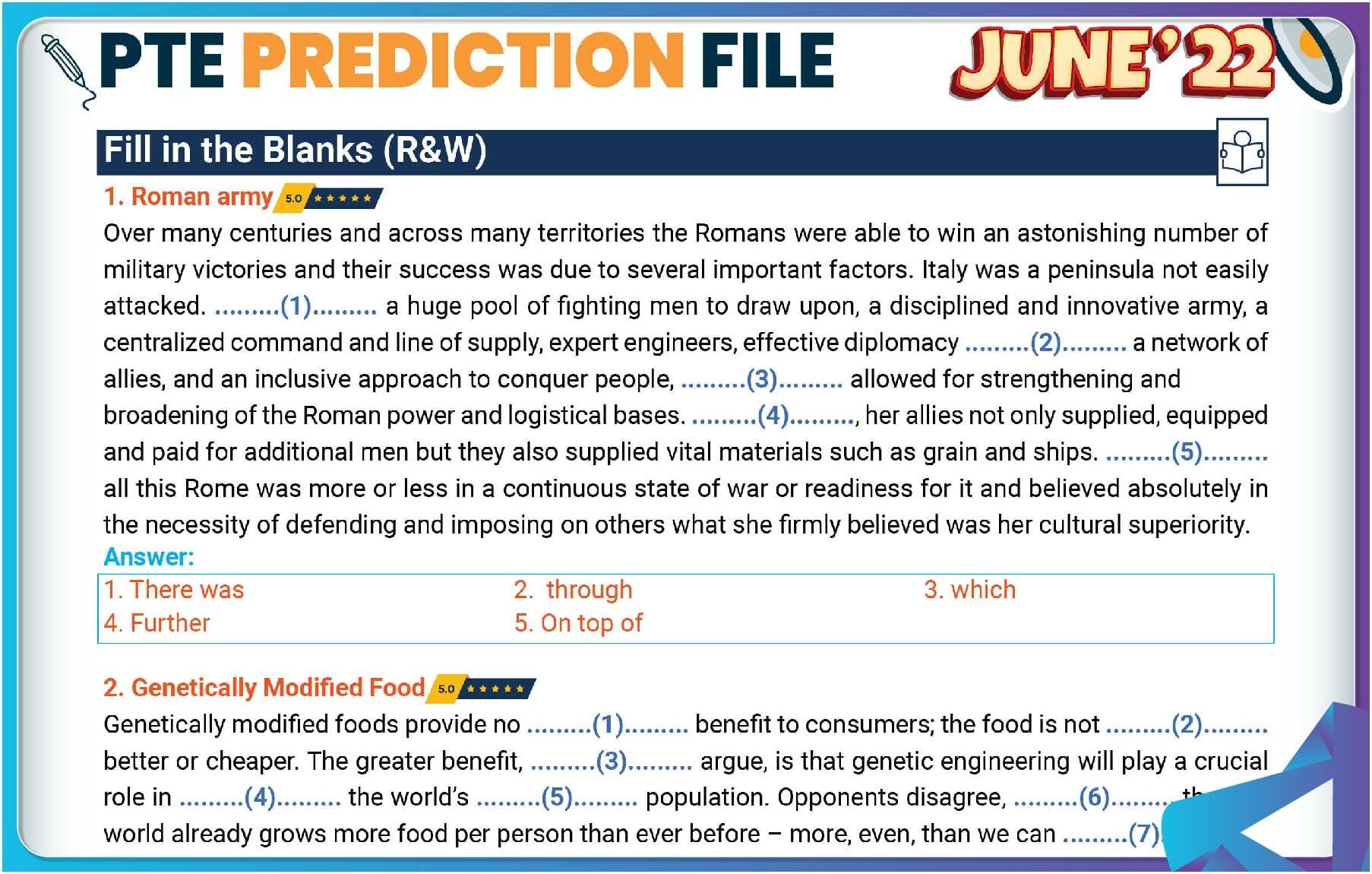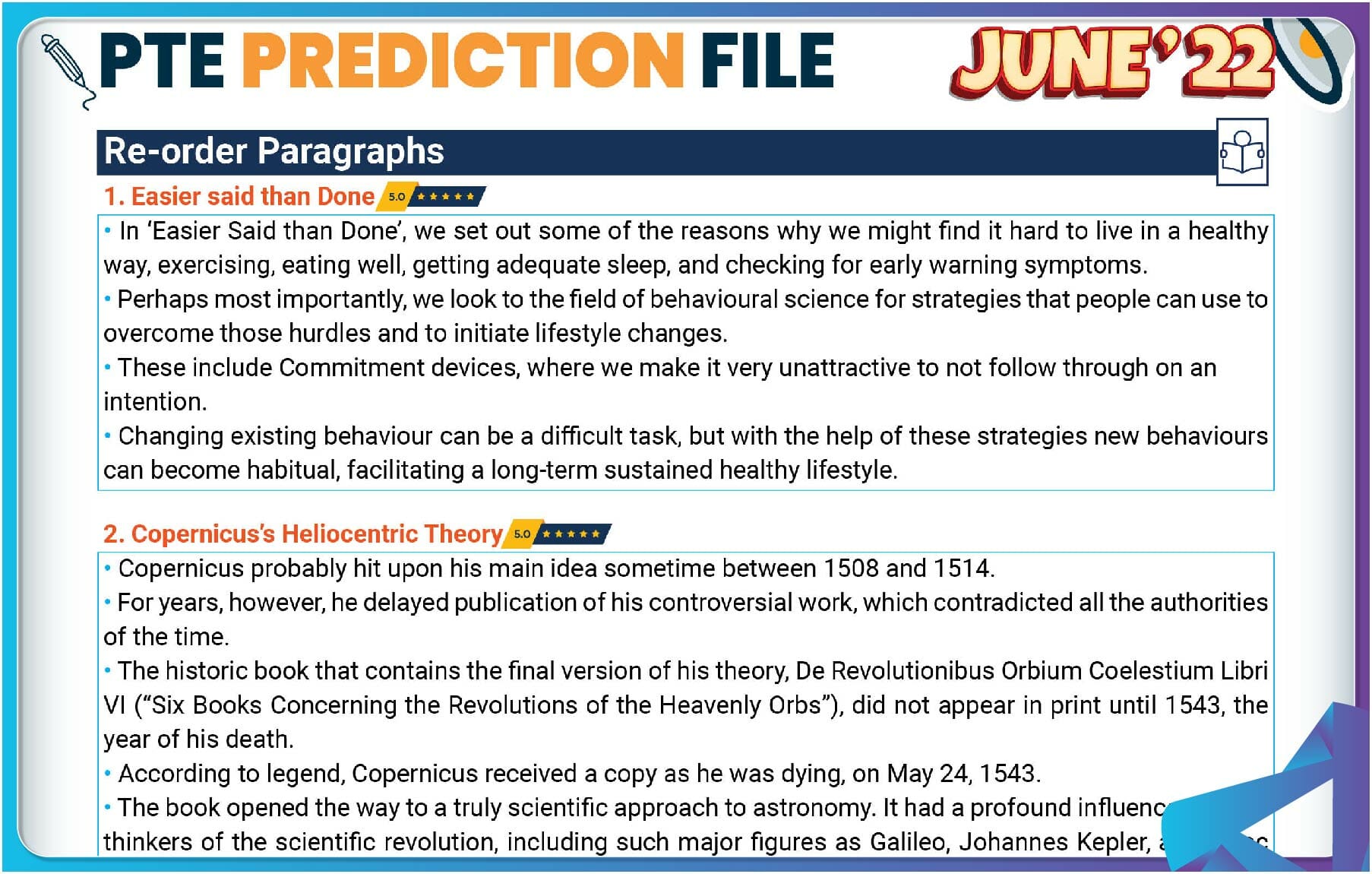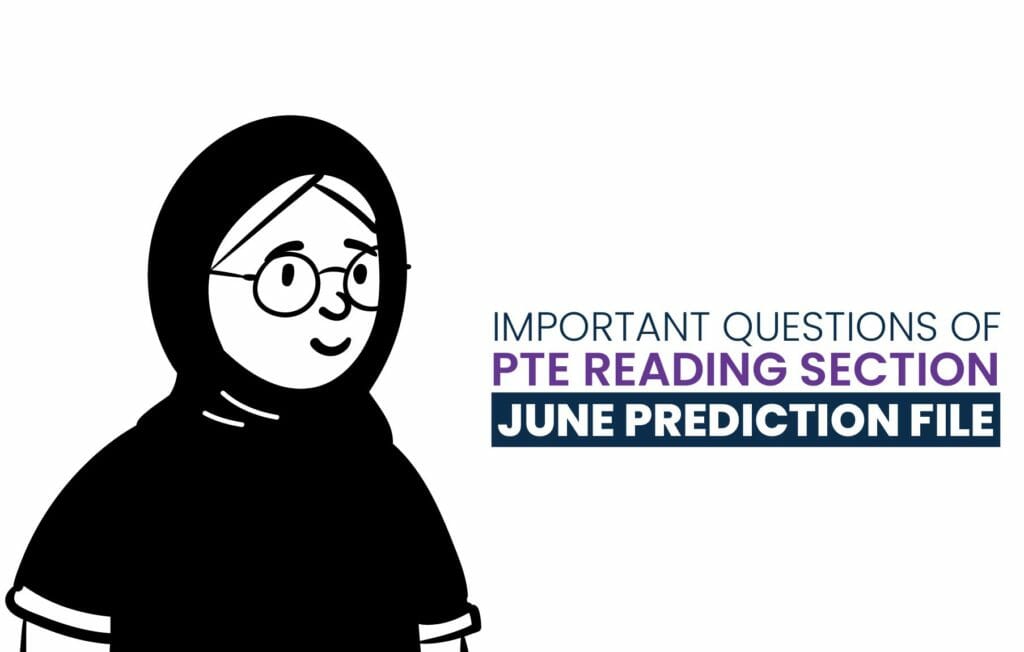Reading is considered one of the toughest sections among all the PTE Sections and the items in PTE reading sections contribute high marks in overall PTE score.
Our monthly prediction file provides a collection of PTE’s most important questions. Before moving forward, let’s have a quick idea about what is a Prediction File?
Our Prediction file is a collection of real exam questions for the PTE Exam that may appear in future exams also. It is developed on continuous checking of the frequency of any question’s repetition in 40 PTE Centres in 12 countries. We bring a new prediction file every month and our students get an overall 60% of common questions from this file.
This June our prediction file has a more than 60% of hit rate for the PTE exam. Let’s check the most important questions from the PTE Reading section that are predicted to appear in the PTE exam in the month of June.
In the Reading section, there are 5 types of questions,
⇒Fill in the Blanks (Drop-Down)
⇒Fill in the Blanks (Drag & Drop)
⇒Reorder Paragraph
⇒Multiple Choice, Choose Single Answer (MCQ Single)
⇒Multiple Choice, Choose Multiple Answers (MCQ Multiple)

In Reading and Writing Fill in the blanks, you get a paragraph and in the blanks, there is a drop-and-down menu. You click on that drop and-down menu and there are 4 options. You need to select the answer from there. So, The (R+W) FIB is all about drag and drop. You will get 5-6 tasks and that will get you 25-36 marks. You will get 2 – 2.30 minutes for each of these tasks.
Scoring System:
This item follows partial scoring. You can score for each correct answer and get 0 for each incorrect answer.
Importance of (R+W) FIB:
Reading & Writing FIB is one of the most important items of PTE which contributes to both reading and writing sections both. This item gets you 23 % marks in Reading and 20% marks in Writing. So, there is no scope to avoid this item.
Strategies and Techniques:
(R+W) FIB is dependent on Vocabulary. Vocabulary is very important for this item. Collocation is most important for (R+W) FIB. Vocabulary is something that you need to practice again & again. Collocation can be improved by improving vocabulary,
Reading FIB is dependent on Grammar. Grammars are general rules. If you know the rule, you can answer the questions easily. You need to follow the basic subject structure and some grammatical rules to do well in this task.
Basic Sentence Construction:
Sub+Verb+Obj = Meaningful
-
Subject = The doer of the action (someone & something)
-
Verb= Action
-
Object = Receiver of the action (Someone or something)
(Note: You can have a sentence without an object. You can have a sentence without a subject. But a sentence will never make sense without a verb. A sentence without a verb is called a Phrase.)
Subject-Verb Agreement: This is the single most important grammar for Reading FIB.
-
Subject = Singular/ Plural
Main verb = Plural/ Singular
-
Subject = Singular/ Plural
Helping verb(am/is/are/was/were/…) = Singular/ Plural
(Note: Verb depends on the subject. ‘And’ compounds the subjects and make it plural)
There are some exceptions to the subject.
If there is ‘No/Every / Some / Any’ in any sentence, they are treated as singular.
Parts of Speech:
We know that there are 8 parts of speeches. But there is a difference between the uses of parts of speech in America and British. In the American language, there are 9 parts of speech as they count Articles (A/An/The) as a part of speech. On the other hand, in British, they follow the regular 8 parts of speech in the sentence structure.
Exam Tips:
-
To – verb- Base form
-
Did- Verb – Base form
-
Modal verbs- Verb- Base form
-
Be – verb- Present continuous +past
-
Been – verb- Present continuous +past participle
-
Is/Are – Verb – Present continuous +past participle
-
Has/ Have – Past participle
-
By- before past participle and after a noun- Passive sentence
Top 5 FIB (Drop-Down) from the June prediction file,
1. Roman army
Over many centuries and across many territories the Romans were able to win an astonishing number of
military victories and their success was due to several important factors. Italy was a peninsula not easily
attacked. ………(1)……… a huge pool of fighting men to draw upon, a disciplined and innovative army, a
centralized command and line of supply, expert engineers, effective diplomacy ………(2)……… a network of
allies, and an inclusive approach to conquer people, ………(3)……… allowed for strengthening and
broadening of the Roman power and logistical bases. ………(4)………, her allies not only supplied, equipped
and paid for additional men but they also supplied vital materials such as grain and ships. ………(5)………
all this Rome was more or less in a continuous state of war or readiness for it and believed absolutely in
the necessity of defending and imposing on others what she firmly believed was her cultural superiority.
Answer:
1. There was 2. through 3. which 4. Further 5. On top of
2. Genetically Modified Food
Genetically modified foods provide no ………(1)……… benefit to consumers; the food is not ………(2)………
better or cheaper. The greater benefit, ………(3)……… argue, is that genetic engineering will play a crucial
role in ………(4)……… the world’s ………(5)……… population. Opponents disagree, ………(6)……… that the
world already grows more food per person than ever before – more, even, than we can ………(7)……….
Answer:
1. direct 2. noticeably 3. proponents 4. feeding 5. burgeoning 6. asserting 7. consume
3. Charles Darwin
Charles Darwin knew intuitively that tropical forests were places of ………(1)……… intricacy and energy.
He and his cohort of scientific naturalists were ………(2)……… by the beauty of the Neotropics, where they
collected tens of thousands of ………(3)……… new to science. But they couldn’t have guessed at the
complete contents of the rainforest, and they had no idea of its ………(4)……… to humankind.
Answer:
1. tremendous 2. awed 3. species 4. value
4. Track down research
Having tracked down research that is ………(1)……… to your area of interest the next task is to actually
make sense of that research. This section is intended to show you how to be critical of the research you
………(2)……… and how to check that the ………(3)……… is credible and represented appropriately.
Unfortunately, this means discussing the ways in which research findings may be misrepresented.
Answer:
1. relevant 2. are reviewing 3. evidence
5. An Act
The Nature Conservation Amendment Act of 1996 enables the Minister of Environment and Tourism to
register a conservancy if it has a ………(1)……… committee, a legal constitution, which provides for the
sustainable management and utilization of game in the conservancy, the ability to ………(2)……… the
funds, an approved method for the ………(3)……… distribution of benefits to members of the community
and defined boundaries.
Answer:
1. representative 2. manage 3. equitable


Reading FIB refers to drag and drop. You will be given a paragraph and there are blanks. All the options are provided on the bottom you need to drag them and drop in the correct blanks. Here whatever the number of the blanks, you get plus three options for that paragraph.
As an example, if there are 5 blanks, you will get 5+3=8 options for that paragraph.
You get 4-5 tasks of this item and that gets you 16-25 marks. You will get 1:30 min- 2 min for each of these tasks.
Scoring System:
This item follows partial scoring. You can score for each correct answer and get 0 for each incorrect answer.
Importance of Reading FIB:
Reading FIB contributes to the Reading section solely. It gets 17% marks in the reading section. So, you need to be very careful about this item.
Top 5 FIB (Drag & Drop) from the June prediction file,
1. Plants and animals
From the earliest civilizations, plants and animals have been portrayed as a means of understanding and
recording the potential uses, such as their economic and healing properties. From the first illustrated
………(1)………. of medicinal plants, De Materia Medica by Dioscorides, in the first century through to the
late fourteenth century the illustration of plants and animals changed very little. Woodcuts in instructional
manuals and herbals were often repeatedly copied over the centuries, resulting in a loss of definition and
accuracy so that they became little more than stylized decoration. With the growing ………(2)………. of
copperplate engravings, the traditional use of woodcuts declined and the representation of plants and
animals became more ………(3)………. Then, with the emergence of artists such as Albrecht Durer and
Leonardo Da Vinci, naturalists such as Otto Brunfels, Leonhard Fuchs in botany and Conrad Gesner and
Ulisse Aldrovandi in zoology, nature began to be ………(4)……… in a more realistic style. Individual living
plants or animals were observed directly and their likeness ………(5)……… onto paper or vellum.
Answer:
1. catalogue 2. popularity 3. accurate 4. depicted 5. rendered
2. The American People
The American People: Creating a Nation and a Society examines U.S. history as revealed through the
………(1)……… of all Americans, both ordinary and extraordinary. With a thought-provoking and rich
presentation, the authors explore the complex lives of Americans of all national ………(2)……… and
cultural backgrounds, at all levels of society, and in all ………(3)……… of the country.
Answer:
1. experiences 2. origins 3. regions
3. Shakespeare’s Works
Shakespeare produced most of his known ………(1)……… between 1589 and 1613. His early plays were
mainly comedies and histories, ………(2)……… he raised to the peak of sophistication and artistry by the
end of the sixteenth century. He then wrote mainly tragedies until about 1608, including Hamlet, King Lear,
and Macbeth considered some of the finest ………(3)……… in the English language. In his last phase, he
wrote tragicomedies, also known as romances, and ………(4)……… with other playwrights.
Answer:
1. works 2. genres 3. examples 4. collaborated
4. Selfies
To better understand selfies and how people form their identities online, the researchers combed through
2.5 million selfie posts on Instagram to determine what kinds of identity statements people make by taking
and sharing the photos. Nearly 52 percent of all selfies ………(1)……… the appearance category: pictures
of people showing off their make-up, clothes, lips, etc. Pics about looks were two times more popular than
the other 14 categories ………(2)………. After appearances, social selfies with friends, loved ones, and pets
were the most common (14 percent). Then came ethnicity pics (13 percent), travel (7 percent), and health
and fitness (5 percent). The researchers noted that the prevalence of ethnicity selfies (selfies about a
person’s ethnicity, nationality or country of origin) is an indication that people are proud of their
backgrounds. They also found that most selfies are solo pictures, ………(3)……… than taken with a group.
Overall, an overwhelming 57 percent of selfies on Instagram were posted by the 18-35-year-old crowd,
something the researchers say isn’t too surprising ………(4)……… the demographics of the social media
platform. The under-18 age group posted about 30 percent of selfies. The older crowd (35+) shared them
far less frequently (13 percent). Appearance was most popular among all age groups. Lead author Julia
Deeb-Swihart says selfies are an identity performance—meaning that users carefully craft the way they
appear online and that selfies are an extension of that. This evokes William Shakespeare’s famous line: “All
the world’s a stage, and all the men and women merely players.”
Answer:
1. fell into 2. combined 3. rather 4. considering
5. Humans began farming
When humans began farming some 12,000 years ago, they altered the future of our ………(1)……… forever.
Our ancestors were ecological ………(2)………, discovering and cultivating the most valuable crops, scaling
them up to feed entire communities, and transforming wild crops so fundamentally that they became
dependent on humans for their survival. Farming, in the words of National Geographic’s Genographic
Project, “sowed the seeds for the modern ………(3)……….”
Answer:
1. species 2. pioneers 3. age


Reorder Paragraph is one of the most difficult topics in PTE. You need to understand how the computer marks to get a good score in this item. Getting a good score is not about knowing good English. It is all about applying the techniques properly. Reading Paragraph is an item from the Reading section and it solely contributes marks in the Reading. You get 2-3 questions in the exam and 2-3 mins per task. You need to click on the sentence and drag and drop it in the target box next to it.
Scoring System:
The scoring system in this item is partial. You need to make a pair of 2 sentences. 1 Correct pair = 1 mark.
⇒If you have 5 sentences in the question, you need to make 4 correct pairs.
⇒If you have 4 sentences in the question, you need to make 3 pairs.
⇒You get a maximum of 5 sentences and a minimum of 4 sentences in the exam.
⇒If the answer is incorrect that means you couldn’t make any correct pair, you get no mark there.
In Reorder Paragraph, Marking depends on the level of the difficulty of the question.
You can get level: 1,2,3,4,5
Your number of correct answers gets multiplied by the level of difficulty. For example, if you make 1 correct answer in the question of difficulty level 3, you get 1*3 = 3 marks for a correct answer and 4*3=12 marks for 4 correct answers.
Strategies & Techniques:
-
Skim the main topic/Idea
-
Scan thoroughly/ Carefully:
-
Keywords=Repeated words
-
Discourse markers=Connectors= Furthermore, Moreover, However, etc.
-
Pronouns: He/She/It/They/Them/That/This/Him/Her
How to identify the pair?
Strategy to Identify the 1st sentence,
-
Introduction of the topic/overview/definition
-
Independent sentence (Sentence that makes meaning itself)
-
Can’t contain discourse markers and pronouns.
-
Article: A/An/The
(Note: Don’t try to find out the 1st sentence if it is difficult. Just try to find the link between the sentence)
The pair order should be like this,
⇒General information>Specific information
⇒Introduction>Body
⇒Idea>Explanation
Find the logical flow in the sentences,
⇒Past>Present>Future
⇒Problem>Solution’
⇒Idea>example
⇒Question>Answer
⇒Full Name> Partial Name
⇒Point> Data/Statistics
In terms of having articles in the sentences, the logical flow will be like this,
The introductory sentence will be without an article> next sentence will be with a/an> then more specific information will start with ‘the’ in it.
In case of timeline, Identify the flow in,
⇒Chronological order: Follow numerical order.
(Note: Generally the flow will be like, Past>Present> Future. But if the change the topic, the order will be changed)
⇒BC vs AD (BC comes first)
⇒Century: 21st century, 18th century
Other terms to Identify the order are: a decade ago, Prior to, Before, After, Until, During, etc.
Special Note:
-
If you are not sure about the answer, just guess and move on. Don’t waste time.
-
Discourse markers without a comma are not considered a connector.
Top 5 Re-order Paragraphs from the June prediction file,
1. Easier said than Done
• In ‘Easier Said than Done’, we set out some of the reasons why we might find it hard to live in a healthy
way, exercising, eating well, getting adequate sleep, and checking for early warning symptoms.
• Perhaps most importantly, we look to the field of behavioral science for strategies that people can use to
overcome those hurdles and to initiate lifestyle changes.
• These include Commitment devices, where we make it very unattractive to not follow through on an
intention.
• Changing existing behavior can be a difficult task, but with the help of these strategies new behaviors
can become habitual, facilitating a long-term sustained healthy lifestyle.
2. Copernicus’s Heliocentric Theory
• Copernicus probably hit upon his main idea sometime between 1508 and 1514.
• For years, however, he delayed publication of his controversial work, which contradicted all the authorities
of the time.
• The historic book that contains the final version of his theory, De Revolutionibus Orbium Coelestium Libri
VI (“Six Books Concerning the Revolutions of the Heavenly Orbs”), did not appear in print until 1543, the
year of his death.
• According to legend, Copernicus received a copy as he was dying, on May 24, 1543.
• The book opened the way to a truly scientific approach to astronomy. It had a profound influence on later
thinkers of the scientific revolution, including such major figures as Galileo, Johannes Kepler, and Isaac
Newton.
3. Writing a research report
• So now that you’ve completed the research project, what do you do?
• I know you won’t want to hear this, but your work is still far from done.
• In fact, this final stage – writing up your research – may be one of the most difficult.
• Developing a good, effective and concise report is an art form in itself.
• And, in many research projects you will need to write multiple reports that present the results at different
levels of detail for different audiences.
4. Vision and echolocation
• Vision and echolocation have many features in common.
• One narrow range of radiation – light in the case of vision, ultrasounds in the case of echolocation provides information relevant to a wide variety of cognitive and practical goals.
• Why, then, is vision so common and echolocation so rare?
• Because, in most environments, vision is much more effective.
• Echolocation is adaptive only in an ecological niche where vision is impossible or badly impaired – for
instance, when dwelling in caves and hunting at night, as bats do.
5. Voice higher than 5khz
• Previous studies have shown that humans are unable to recognize melodies whose notes have a
fundamental tone above 5 kilohertz.
• It was thought that at frequencies, this high, the rapidly cycling sound wave was too fast for the auditory
nerve to cope with.
• To test this theory, Andrew Oxenham and his colleagues at the University of Minnesota in Minneapolis
asked a group of six students whether two four-note melodies were identical or not.
• As in previous studies, the volunteers could not recognize melodies with fundamental tones above 5 kHz.


In Reading MCQ Single, a text is shown for reading. After reading the text a multiple-choice question on the content or tone of the text needs to be answered by selecting one response.

In Reading MCQ Multiple, a text needs to be read and afterward, a multiple-choice question on the content or tone of the text needs to be answered by selecting more than one response.
Scoring system:
You get 1-2 questions for each of the items. You get 1 mark for each correct response and get 0 for each incorrect response.
Types of Questions
There are 2 TYPES of Question
-
Specific
-
What are the features of a penguin that keeps it warm in winter?
-
-
Non-Specific
-
What is the main idea of the passage?
-
-
True or False
-
Not True or not false
-
True except or false expect
-
Can be inferred or can’t be inferred.
-
Can be agreed or can’t be agreed.
Strategy:
-
Skimming and Scanning
-
Reading Questions First
-
Reading Options Second
-
Eliminating Options
-
Selecting ones 100% certain
In MCQ’s elimination method is the best solution to get the answer easily. To Eliminate the options, you need to follow the steps below,
-
Information that doesn’t match what is in the question / being asked
-
Tweaked facts that appear to be the correct answer
-
Opposite details
-
Additional information
-
Partial information
-
Irrelevant information






